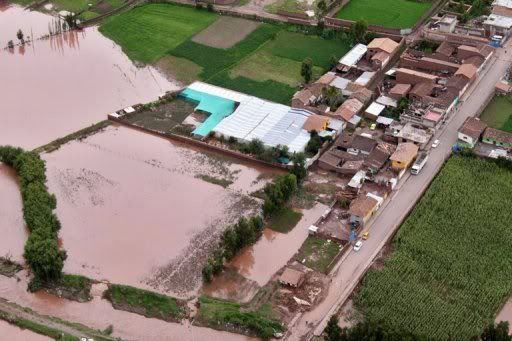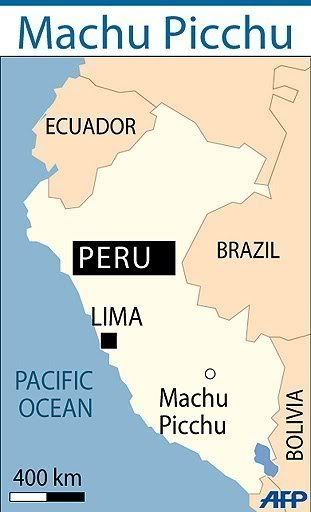
Peru said two bridges were destroyed by the mudslides in Cusco

Machu Picchu was constructed in the 15th century by Pachakuteq -- the founder of the Inca empire

The Machu Picchu ruins attract more than 400,000 visitors every year
Peru used helicopters to airlift foreign tourists trapped by rain and mudslides that killed seven people in and around its famed Machu Picchu ruins, but frustrations grew among the more than 2,500 still stranded.
The operation, which began Monday, by late Tuesday had rescued 125 of the foreigners, most of whom were waiting by a helipad near the ruins themselves, emergency services said.
But another 1,900 were stranded in nearby Aguas Calientes and 670 more on the Inca Trail, a narrow Andean pathway up to Machu Picchu that takes four days to complete and which was cut in several places by landslides.
"People are sleeping in the street square, they are sleeping in gyms, in schools, on trains, in makeshift tents. People are just distressed," Julie Nemcich, 29, told the Australian Broadcasting Corporation from Aguas Calientes.
A 23-year-old Argentine tourist and a 33-year-old Peruvian mountain guide died on the trail, buried under mudslides, the National Culture Institute in the nearby town of Cusco said.
The other fatalities occurred along the valley leading to Cusco and in the town itself. Two Peruvian men drowned in the valley's swollen river, another died in a landslide, and a mother and her child were killed in Cusco when heavy rainfall made their home collapse, emergency officials said.
Some 400 Americans were among the stranded near Machu Picchu, State Department spokesman Philip Crowley said in Washington.
The US embassy in Peru has sent four helicopters -- usually used as part of anti-drug efforts -- to help with evacuation efforts, he said.
"We are very grateful for the efforts of the government of Peru in trying to help with the evacuation of American citizens near Machu Picchu," he said.
In Sydney, Australia's foreign office said up to 170 Australians were among those stranded.
"We are in direct contact with many of those Australians and their tour providers, who we understand are making alternative transport arrangements," a spokeswoman said.
Tourists forced to wait in the town of Aguas Calientes near the ruins were uncomfortable and frustrated, she said.
"But we urge them to exercise patience and await evacuation by the Peruvian authorities," she said.
Fernando Celis, one of 300 Chileans blocked in Machu Picchu, complained to the online news website Emol that some tourists were bribing rescuers to get them out first.
"A helicopter arrived yesterday to take out the elderly and the unwell and some tourists who had more money. There are almost no North Americans left, only the backpackers, and British backpackers. People on tours who were waving their money about, they were all evacuated," he said.
He said food was running short.
"We haven't been given anything to eat. Each one is left to work out his rations," he said, adding that the vendors at the tourist site had immediately doubled their prices when it became clear the foreigners were stuck.
Machu Picchu is one of the most popular destinations for tourists in Latin America, attracting more than 400,000 visitors a year.
The 15th-century Inca fortress is located on a high mountain ridge 70 kilometers (40 miles) from Cusco. A railway that transports tourists to the site was covered by a mudslide.
The country's civil defense service estimated the homes of 1,300 people in poor rural areas -- many of them riverside dwellings made of clay and straw -- had been destroyed. Another 12,000 people were affected to a lesser degree, losing possessions or suffering property damage.
Authorities were sending tons of food and other aid from Lima to Cusco by air and by road, including 1,000 tarpaulins for those left homeless.
Peru's presidential chief of staff Javier Velasquez traveled to Cusco with emergency-level ministers and officials to evaluate the situation and coordinate rescues.
The town has declared a 60-day state of emergency after seeing two bridges collapse and 250 houses destroyed.
Peru scrambled helicopters to evacuate some 2,000 tourists stranded in the Andes on Tuesday after torrential rains and mudslides killed 5 people and cut off access to Peru's ancient Inca citadel of Machu Picchu.
Tourists became trapped at the World Heritage site in the jungle in eastern Peru after the heaviest rains in the area in 15 years flooded the zone over the weekend.
An Argentine tourist and a Peruvian guide were killed along the trail in separate mudslides, the government said, while two other deaths were reported over the weekend. The fifth person was killed when a hillside collapsed.
Prime Minister Javier Velasquez, who visited the area on Tuesday, said some 250 homes were washed away by the rains, as well as bridges and parts of several highways.
Television images showed roads completely covered by fast-moving water and fallen rock. People sought to cross swollen rivers on foot, submerged up to their chests.
"The situation is chaotic," Washington Farfan, a guide at Machu Picchu, told Reuters by telephone from the site as tourists waited for a helicopter ride out.
"Unfortunately, the rescue effort has not been organized correctly. People are really upset right now," he added.
Machu Picchu, which was built in the mid-15th century and lies some 680 miles (1,100 km) southeast of Lima, is Peru's top tourist destination. Roughly a million people visit the site, which sits around 7,874 feet (2,400 metres) above sea-level, each year.
The government declared a state of emergency and the company that runs trains between the Inca ruins and the nearby city of Cusco suspended services.
Aside from the train, the only way to reach the ancient Incan site is to trek some 28 miles (45 km) through the mountains, a trip that takes on average 3 to 4 days.
"We're doing everything that's humanly possible to evacuate tourists," Trade and Tourism Minister Martin Perez told CPN radio.
He said the government was sending up to 10 helicopters to help in aid efforts, but that their arrival would depend on the weather.
"Everyone is fighting for a place on the helicopter ... The help we've received so far is not enough," a Peruvian tour guide told CPN radio.
An Argentine tourist told the same station that travelers' spirits were low and communication difficult.
"We have nothing to eat and have no idea for how much longer we're going to have water," he said.
---------
---------
--------
--------
ReAd more about Peru.
















0 comments:
Post a Comment